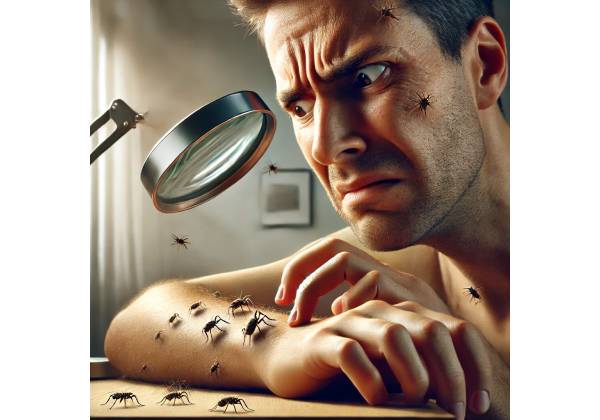
What is acarophobia?
Acarophobia is an intense and irrational fear of small insects, particularly mites and ticks, and the belief that one’s skin is infested with these tiny creatures. Individuals with acarophobia experience intense anxiety at the prospect of being exposed to mites or feeling insects crawling on their skin, even when no such pests are present. This condition can be extremely distressing, causing sufferers to engage in repetitive behaviors like excessive scratching, cleaning, or inspecting their skin.
Although fear of insects is common, acarophobia is more than just aversion. Individuals may become preoccupied with the possibility of contamination or infestation, disrupting their daily routines and overall quality of life. What distinguishes acarophobia is the level of distress felt and the persistence of the fear, which can last for long periods of time and lead to compulsive behaviors aimed at preventing or eliminating the perceived threat.
Recent research has found that acarophobia, like other specific phobias, is frequently associated with anxiety disorders. This condition can develop in response to a traumatic experience with mites, an underlying health condition, or in combination with other psychological factors. For many people, acarophobia can be an isolating and difficult condition to manage without the right support, but recognizing the symptoms and seeking professional help are critical steps toward overcoming the fear.
Symptoms of Acarophobia
Acarophobia causes a variety of physical, emotional, and behavioral symptoms, which can be overwhelming for those affected. Recognizing these symptoms early is critical for getting the right treatment and support. Below, we break down the main manifestations of acarophobia:
1. A persistent fear of mites or ticks
The primary symptom of acarophobia is an overwhelming and irrational fear of small insects, particularly mites and ticks. Individuals with acarophobia may become hyper-aware of their surroundings, constantly looking for signs of these pests. The mere mention of mites or ticks, or seeing an insect, can cause an immediate and intense sense of dread. This fear can become overwhelming, resulting in avoidance behaviors designed to prevent any interaction with the feared insects.
2. Physical sensations of crawling or itching
A common symptom of acarophobia is the sensation that insects are crawling on or beneath the skin, even when no such pests exist. These physical sensations, known as formication, can be extremely uncomfortable and distressing. People may describe:
- Itching or prickling sensations on the skin
- Repeated scratching, which can sometimes cause skin damage or sores.
- Tingling or burning sensations, especially on exposed areas like the arms and legs.
These sensations are frequently amplified by anxiety, resulting in a feedback loop in which the fear of insects heightens physical symptoms, exacerbating the fear.
3. Excessive Skin Examination and Grooming
Many people suffering from acarophobia engage in compulsive behaviors to eliminate the perceived threat of infestation. These behaviors could include:
- Continually inspecting the skin for signs of insects or bites.
- Regular washing or bathing in order to “cleanse” the skin of mites.
- Scrubbing or using harsh chemicals on the skin in order to remove any trace of pests
- Seeking reassurance from others that there are no insects.
While these behaviors may temporarily alleviate anxiety, they can be harmful over time. Repetitive grooming, for example, can cause skin irritation, infections, and even permanent dermatological damage.
4. Avoidance of specific environments or situations
Individuals with acarophobia may go to great lengths to avoid situations in which they believe they will be exposed to mites or ticks. This could lead to:
- Avoiding outdoor spaces, such as parks or gardens, where ticks or mites may be present
- Reluctance to visit specific homes or buildings that the individual believes are infested
- Refusing to wear certain types of clothing, such as wool or other fabrics associated with attracting mites.
This avoidance behavior can severely limit an individual’s ability to participate in normal daily activities, cutting them off from social and professional opportunities.
5. Emotional and psychological distress
Acarophobia can cause significant emotional turmoil, resulting in:
- Increased anxiety or nervousness due to the perceived threat.
- Feelings of panic or fear when thinking about or encountering insects
- Increased irritability, especially when others dismiss or minimize their fears.
- Difficulty concentrating on tasks because the individual’s mind is frequently preoccupied with fears of infestation.
This emotional distress can have a significant impact on a person’s mental health, potentially leading to depression or generalized anxiety disorder.
6. Sleep Disruption
The fear of mites or ticks frequently causes difficulty sleeping. Individuals may stay awake because they are concerned about insects infesting their bedding or crawling on them while sleeping. As a result, they might experience:
- Insomnia caused by hypervigilance or fear.
- Insect-related nightmares.
- Regular waking to inspect for signs of infestation.
- Exhaustion from lack of sleep, which exacerbates anxiety
The combination of disturbed sleep and increased anxiety creates a vicious cycle that is difficult to break without intervention.
Causes and Risk Factors for Acarophobia
Understanding the underlying causes of acarophobia is essential for developing effective treatment strategies. Although the exact causes of the condition can vary, the following factors are frequently associated with the development of acarophobia:
1. Traumatic Experiences
One of the most common causes of acarophobia is a previous traumatic encounter with mites, ticks, or other pests. A severe insect bite or infestation can instill a strong fear of recurrence, resulting in the development of acarophobia. In some cases, the traumatic event occurred during childhood, and the fear returned or became more intense later in life.
2. Learned behavior and observational learning
Children and adults can develop acarophobia through observational learning, which occurs when they see others reacting fearfully to insects or mites. This can happen in a family or social setting, where a person learns to associate insects with danger based on the reactions of others. Even if the individual has never faced a significant threat from insects, these learned fears can solidify over time and become a phobia.
3. Underlying Anxiety Disorders
Acarophobia frequently coexists with other anxiety disorders. People with generalized anxiety disorder, obsessive-compulsive disorder, or other phobias may be more likely to develop acarophobia. In these cases, insect fear could be part of a larger pattern of anxious thinking and increased sensitivity to potential environmental threats.
4. Health issues or sensory disturbances
Certain medical conditions, particularly those involving the skin, can exacerbate acarophobia. For example:
- Dermatological conditions, such as eczema or psoriasis, can cause feelings of itching or crawling, leading people to believe they are infested with mites.
- Neurological conditions that cause abnormal skin sensations (e.g., neuropathy) can precipitate or worsen acarophobia.
In some cases, fear may arise as a result of increased bodily awareness, in which people become overly focused on normal sensations and misinterpret them as signs of infestation.
5. Media and Public Health Campaigns
Acarophobia can sometimes be triggered by media coverage or public health campaigns involving insect-borne diseases. For example, news stories about Lyme disease outbreaks (transmitted by ticks) can raise awareness and fear of these pests, especially among people who are predisposed to anxiety. If not managed properly, this fear can quickly become a full-blown phobia.
How is acarophobia diagnosed?
A licensed mental health professional usually diagnoses acarophobia after conducting a thorough evaluation. Diagnosing acarophobia requires several key steps:
1. Psychological Evaluation
A mental health professional, such as a psychologist or psychiatrist, will conduct an in-depth interview with the individual to determine the nature of their fear, the severity of their symptoms, and the impact the phobia has on their daily life. During this evaluation, the clinician may ask questions like:
- Specific fears regarding mites or insects
- Behavioral patterns, such as avoidance and compulsive skin inspection
- Other anxiety-related symptoms may indicate a larger anxiety disorder.
2. Diagnostic criteria
Acarophobia is classified as a specific phobia under the Diagnostic and Statistical Manual of Mental Disorders (DSM-5). To meet the diagnostic criteria, the individual must demonstrate:
- Persistent, irrational fear of mites or insects.
- Instant anxiety responses when exposed to triggers.
- Make significant efforts to avoid contact with the feared insects or their surroundings.
- The phobia must disrupt daily functioning and cause distress for at least six months.
The clinician will use this framework to determine whether the fear is classified as acarophobia or if other diagnoses, such as obsessive-compulsive disorder or delusional infestation, are more appropriate.
3. Differential Diagnosis
It is critical to distinguish acarophobia from other related conditions. For example:
- Delusional parasitosis is a condition in which people believe they are infested with parasites, often without any evidence. This is not the same as acarophobia, in which the individual recognizes the fear as irrational.
- Obsessive-compulsive disorder may include fears of contamination or infestation, but these concerns are part of larger obsessive-compulsive patterns.
The mental health provider may investigate these conditions to ensure a correct diagnosis and treatment.
Effects of Acarophobia on Daily Life
Acarophobia can cause significant disruptions in daily life, especially as the fear and avoidance behaviors become more entrenched. Acarophobia can affect the following areas of daily life:
1. Physical Health
Acarophobia-related compulsive behaviors, such as excessive scratching, scrubbing, or the use of harsh cleaning agents, can have serious physical consequences. Some common consequences are:
- Skin damage, such as rashes, abrasions, or sores, caused by frequent scratching or using strong cleaning products.
- Infections caused by broken skin and subsequent exposure to bacteria.
- Sleep disturbances, as fear of mites or insects can cause insomnia or disrupted sleep, resulting in fatigue and weakening the immune system over time.
These physical health issues can cause a vicious cycle of anxiety for people suffering from acarophobia. As skin damage worsens, the individual may become more convinced that they are infested, heightening fear and leading to more compulsive behaviors.
2. Social and Professional Life
Acarophobia, which causes avoidance behaviors and distress, can severely limit social interactions and professional commitments. Individuals may:
- Avoid visiting friends or family members, especially if they believe these places may have mites or ticks.
- Withdraw from social events, fearing possible exposure to insects or being judged for their hygiene habits.
- Struggle to retain employment, especially in roles that require travel, interaction with nature, or close contact with other people.
In severe cases, the phobia can lead to isolation because the individual is embarrassed about their fears or worried that others will dismiss their concerns. Over time, this isolation can worsen anxiety and depression.
3. Emotional and Psychological Wellbeing
Living with acarophobia can have a significant impact on a person’s emotional and psychological health. Constant concern about mites, stress from avoidance behaviors, and preoccupation with skin sensations can lead to:
- Chronic anxiety, which can spread to other areas of life.
- Depression, especially if the person feels hopeless about overcoming their phobia or feels shame or embarrassment about their condition.
- Increased irritability, as the persistent fear and discomfort can make it difficult to focus on other tasks or maintain relationships.
Acarophobia can sometimes lead to the development of other mental health conditions like obsessive-compulsive disorder (OCD) or panic disorder, complicating treatment and management.
4. Financial Impact
For some people, the fear of infestation results in significant financial costs. Individuals with acarophobia may:
- Invest excessively in cleaning products, pesticides, or home treatments to rid their environment of perceived mites.
Invest in professional extermination services, even if there is no evidence of an infestation. - Replace bedding, furniture, or clothing on a regular basis due to concerns that they may harbor insects.
These expenses can quickly accumulate, putting a financial strain on the individual or their family, especially if the phobia has also hampered their ability to work.
Treatment Alternatives for Acarophobia
Acarophobia is a treatable condition, and with the right approach, people can significantly reduce their fear and reclaim control of their lives. Treatment usually consists of a combination of psychological therapies, medications, and self-help strategies designed to address both the anxiety and behavioral aspects of the phobia. Here are the most effective treatments for acarophobia:
1. Cognitive behavior therapy (CBT)
Cognitive Behavioral Therapy (CBT) is widely considered one of the most effective treatments for specific phobias, such as acarophobia. This therapy focuses on identifying and challenging the irrational thoughts that contribute to the phobia, as well as assisting individuals in developing healthier coping mechanisms. Key components of CBT for acarophobia are:
- Cognitive restructuring, where the therapist assists the individual in identifying distorted beliefs about mites or ticks and replacing them with more realistic, balanced thoughts.
- Behavioral techniques, such as exposure therapy, which gradually exposes the individual to the feared situation (e.g., being in environments where mites may be present) in a controlled and safe manner. Exposure gradually reduces the fear response and desensitizes the individual to anxiety-provoking stimuli.
For example, in exposure therapy, the individual may first be asked to look at pictures of mites before progressing to spending time outside where mites or ticks are more likely to be present. The goal is to reduce anxiety by exposing the individual to their fear repeatedly and safely.
2. Exposure Therapy
Exposure therapy is frequently used in conjunction with cognitive behavioral therapy, but it can also be used on its own. This approach works by gradually confronting the individual’s fears, allowing the brain to rewire its response to the feared object or situation. Exposure therapy for acarophobia may include the following:
- Gradual desensitization, in which the person first confronts less anxiety-provoking stimuli (e.g., learning about mites) and gradually progresses to more direct encounters (e.g., handling objects associated with mites).
- Virtual reality exposure, in which the individual experiences simulated environments with insects or mites, providing a controlled way to confront their fears without direct exposure.
Over time, repeated exposure reduces the individual’s anxiety response, allowing them to regain control of their reactions to perceived threats.
3. Medications
In some cases, medications may be prescribed to help manage acarophobia symptoms, especially if the phobia is associated with severe anxiety or coexists with other mental health conditions. Acarophobia is commonly treated with the following medications:
- Selective Serotonin Reuptake Inhibitors (SSRIs): These antidepressants are frequently prescribed to treat anxiety and are especially beneficial for people who have panic attacks or obsessive-compulsive behaviors associated with their phobia.
- Benzodiazepines: These are short-term medications that treat acute anxiety or panic attacks. They are not recommended for long-term use due to the possibility of dependence.
- Beta-blockers: These medications help manage anxiety’s physical symptoms, such as rapid heartbeat or trembling, by blocking the effects of adrenaline.
It is important to note that medications are typically used in conjunction with therapy rather than as a standalone treatment, as they help alleviate symptoms but do not address the underlying fear.
4. Meditation and Relaxation Techniques
Mindfulness and relaxation exercises can be useful tools for people suffering from acarophobia, assisting them in managing the stress and anxiety that is frequently associated with the condition. Techniques like deep breathing, progressive muscle relaxation, and guided imagery can help to calm the mind and body, especially during times of high anxiety. Mindfulness encourages people to focus on the present moment, which can help them stop ruminating about mites or ticks and prevent fear from escalating.
Mindfulness-based stress reduction (MBSR) programs, which combine mindfulness meditation with cognitive strategies, have also demonstrated promise in assisting people with phobias in managing their symptoms.
5. Supportive Counseling
For many people, supportive counseling provides a safe place to express their fears and anxieties without being judged. This type of therapy emphasizes emotional support, assisting the individual in processing their emotions and exploring coping strategies for their phobia. While not a replacement for CBT or exposure therapy, supportive counseling can be an effective tool for those suffering from acarophobia, particularly in addressing the emotional toll of the condition.
6. Self-help Strategies
Individuals with acarophobia can use a variety of self-help strategies in addition to professional treatment. These strategies are aimed at managing anxiety, reducing avoidance behaviors, and developing a sense of control over the phobia. The key self-help techniques are:
- Developing a fear hierarchy: Gradually exposing oneself to feared situations in a stepwise manner, beginning with less anxiety-provoking stimuli and progressing to more challenging scenarios.
- Setting small, manageable goals: Breaking down exposure tasks into smaller, more achievable steps to gradually build confidence and reduce anxiety.
- Journaling: Keeping a record of anxious thoughts, physical symptoms, and progress in managing the phobia can provide insight and encourage ongoing improvement.
These self-help techniques work best when combined with professional therapy, allowing individuals to develop resilience and autonomy in managing their phobia.
7. Group Therapy and Support Groups
For some people, group therapy or participation in support groups can help them overcome their acarophobia. Being part of a group of people who share your fears can help you feel less isolated and more connected. Group therapy allows participants to learn from one another’s experiences, share coping strategies, and be encouraged by those who have made progress in managing their phobia.
Support groups can also offer practical advice for dealing with the daily challenges of acarophobia, as well as emotional support in a nonjudgmental environment.










